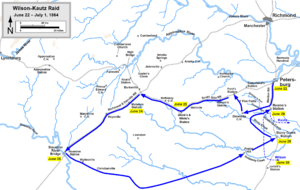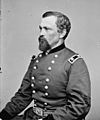Wilson–Kautz Raid facts for kids
Quick facts for kids Wilson-Kautz Raid |
|||||||
|---|---|---|---|---|---|---|---|
| Part of the American Civil War | |||||||
 A map depicting the circuitous route taken by Union cavalry forces in the Wilson-Kautz Raid |
|||||||
|
|||||||
| Belligerents | |||||||
| Commanders and leaders | |||||||
| James H. Wilson August Kautz |
William Mahone William Henry Fitzhugh Lee Wade Hampton |
||||||
| Strength | |||||||
| 2 Union cavalry divisions (5,000) | Lee's Confederate cavalry division (?), Hampton's cavalry division (4 brigades), Mahone's infantry division (?) | ||||||
| Casualties and losses | |||||||
| 1,500 and 12 guns | ? | ||||||
The Wilson–Kautz Raid was a special operation by cavalry (soldiers on horseback) in south-central Virginia during the American Civil War. It happened in late June 1864, early in the Richmond-Petersburg Campaign. The raid was led by Union cavalry generals James H. Wilson and August Kautz. Their mission was to destroy important railroad tracks. These tracks connected Lynchburg, Virginia to Petersburg, Virginia, a key supply center for the Confederate side.
The raid did cause problems for Confederate rail lines for several weeks. However, the Union forces lost many of their cannons and all their supply wagons. They also lost almost a third of their soldiers, mostly captured by the Confederates.
Contents
Why the Raid Happened
Right after the Overland Campaign, the main Union Army commander, Ulysses S. Grant, had a plan. He wanted to surround both the Confederate capital, Richmond, and its important supply city, Petersburg. Petersburg was only ten miles south of Richmond.
While his foot soldiers (infantry) started digging trenches around Petersburg, Grant decided to use his new positions. He planned to send out smaller, fast-moving groups to mess up the enemy's railroad lines.
On June 22, 1864, 5,000 Union cavalry soldiers were pulled from the Petersburg siege. They also had 16 artillery (cannon) pieces. These forces, led by Generals James H. Wilson and August Kautz, were sent to destroy the Confederate supply lines.
Who Was Fighting
Here are some of the main commanders involved in the Wilson-Kautz Raid:
| Union Commanders |
|---|
|
| Confederate Commanders |
|
|
Key Battles of the Raid
The Union cavalry faced several challenges and battles during their mission.
Battle of Staunton River Bridge (June 25, 1864)
Even though Confederate cavalry, led by General W.H.F. "Rooney" Lee, chased and bothered them, the Union cavalry managed to destroy 60 miles of railway in just three days.
As they got close to the bridge over the Staunton River, Union scouts thought they saw Confederate soldiers arriving by train. But this was a clever trick! Confederate Captain Benjamin L. Farinholt used this time to gather a group of "Old Men and Young Boys" from nearby areas. This group included regular soldiers, reserve soldiers, local volunteers, and six cannons.
When the Union cavalry finally attacked, Farinholt's group was ready in their positions. They successfully fought off the larger Union force. A few hours later, Lee's chasing cavalry caught up with Wilson's soldiers at the back. Even with their earlier success, Kautz's men could not destroy the railroad bridge. The Union force then turned back to the east.
Battle of Sappony Church (June 28, 1864)
After more than a week of constant fighting in enemy land, Wilson's and Kautz's groups crossed the Nottoway River. They reached the Stony Creek Depot on the Wilmington and Weldon Railroad. They were now only ten miles from friendly Union lines.
But before they reached Stony Creek, they were attacked by General Wade Hampton's cavalry division, which blocked their path. Lee's cavalry group again attacked the Union force from behind. The Union soldiers were forced to move north toward the crossing at Ream's Station.
First Battle of Ream's Station (June 29, 1864)
The tired Union raiders moved toward Ream's Station, expecting it to be held by friendly forces. Instead, they found themselves almost surrounded. They were attacked by Confederate foot soldiers led by General William Mahone and by Lee's cavalry, who kept chasing them.
Generals Wilson and Kautz had to leave behind their cannons and burn their remaining supply wagons. They split up and tried to break out eastward toward Union forces led by General Benjamin F. Butler. Kautz's group moved across the countryside to the southeast, reaching friendly lines after sunset. Wilson's group suffered many losses. They pulled back to the southwest, then circled eastward again to cross the Nottoway River. Finally, they reached safety at Light House Point on July 2.
What Happened Next
The Wilson-Kautz Raid was not a complete success for the Union. Along with another Union setback at the Jerusalem Plank Road, this raid added to the frustration felt by General Grant, President Lincoln, and people in the North. Even though the raid did help trap Confederate General Lee in a defensive position at Petersburg, its partial failure also set the stage for Jubal Early's raid on Washington two weeks later.





